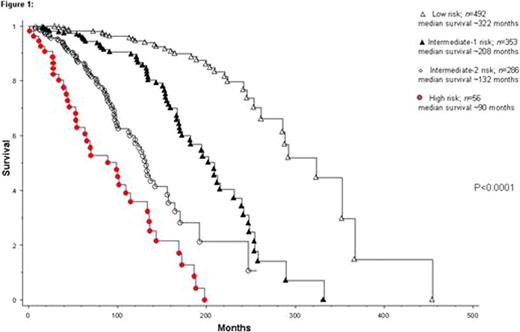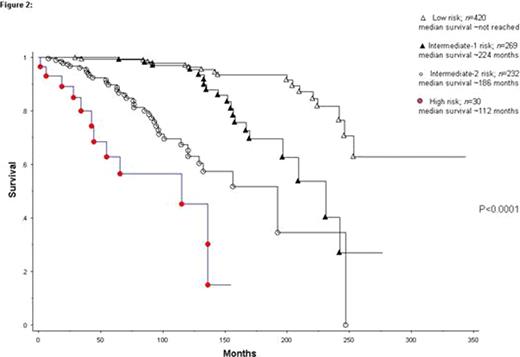Abstract
Abstract  277
277
Current information on the natural history of polycythemia vera (PV) is mostly derived from early studies based on the PV Study Group diagnostic criteria. The World Health Organization (WHO) diagnostic approach to PV is currently the gold standard. The main objective of the current study was to describe survival, disease complication rates and risk factors in WHO-defined PV.
Under the auspices of an International Working Group, seven international centers of excellence for myeloproliferative neoplasms submitted a total of 1,430 patients, locally diagnosed with “WHO-defined PV”. The two principle investigators (AT and TB) reviewed all the cases and selected 1,263 patients who were age 18 years or older, diagnosed after 1970, and whose submitted data included diagnostically essential information.
Median age was 60 years (range, 18–95; 51% females). The number of patients diagnosed between 1970–1990, 1991–2000, and 2001–2011 were 136 (11%), 337 (27%) and 790 (62%), respectively. Arterial/venous thrombosis history before or at diagnosis was documented in 142/73 and 80/42 patients, respectively. Other features at diagnosis included pruritus (37%), microvascular disturbances (29%), palpable splenomegaly (37%), abnormal karyotype (13%), and leukoerythroblastosis (6%). History of hypertension (45%), hyperlipidemia (17%), diabetes (9%), and tobacco use (15%) was also obtained.
To date, 228 (18%) deaths, 42 (3%) leukemic progressions, and 101 (8%) fibrotic transformations have been recorded. Post-diagnosis arterial or venous thrombosis occurred in 139 (11%) and 85 (7%) patients, respectively. Cytoreductive therapy had not been used in 342 (27%) patients whereas 154 (12%) patients were exposed to two or more cytoreductive drugs.
Multivariable analysis identified advanced age, leukocytosis, venous thrombosis history and abnormal karyotype as significant (p<0.01) risk factors for overall survival (OS). Receiver operating characteristic (ROC) plots delineated ages 69 (AUC 0.83) and 59 (AUC 0.61) years and leukocyte count 13 × 109/L (AUC=0.61) as the best discriminant levels in this regard; HR (95% CI) were 11.4 (7.7–16.9) for age ≥70 years, 3.8 (2.6–5.7) for age 60–69 years, and 2.0 (1.5–2.6) for leukocyte count ≥15 × 109/L.
HR-based risk scores were assigned to age ≥70 years (3 points), age 60–69 years (2 points) and leukocyte count ≥15 × 109/L (one point), in order to create four risk groups: low (zero points; n=492; median survival 322 months), intermediate-1 (one or 2 points; n=353; median survival 208 months; HR 3.8, 95% CI 2.5–5.8), intermediate-2 (3 points; n=286; median survival 132 months; HR 10.7, 95% CI 6.9–16.5), and high (4 points; n=56; median survival 90 months; HR 22.7, 95% CI 13.9–37.1) (Figure 1). Similar results were obtained when analysis was restricted to the 1,011 JAK2 mutation-positive patients (Figure 2). The particular risk model was equally robust in predicting leukemia-free survival (p=0.001).
Age and leukocyte count matter the most in predicting survival in PV. The current study suggests additional prognostic value from karyotype and venous thrombosis history.
Vannucchi:Novartis: Honoraria. Gisslinger:Novartis: Speakers Bureau; Celgene Austria: Speakers Bureau; AOP-Orphan: Speakers Bureau.
Author notes
Asterisk with author names denotes non-ASH members.

This icon denotes a clinically relevant abstract



This feature is available to Subscribers Only
Sign In or Create an Account Close Modal